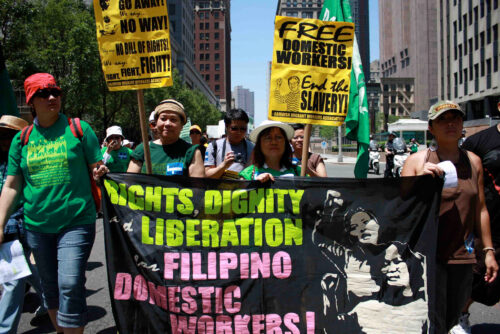Newly independent nations emerging from decolonization entered a world system in which the nation-state was the normative unit of sovereignty recognized by the postwar world. Yet after the establishment of the state, the new national governments—often provisional, not yet “legitimate”—created new societies with difficulty; there were internal and external obstacles to the redistribution of sovereignty, land, and economic power necessary for actual “decolonization.”1 The period of newly emerging independent nations converged with U.S. postwar economic interests in expansion and investment abroad; U.S. “development” projects often created new dependency or reproduced old inequality for the new nations.2 In this sense, while scholars and statesmen have tended to cast postcolonial nationhood as the vehicle for third world “progress” and entry into the modern world of nations, statehood for the formerly colonized has rarely meant actual autonomy and self-determination.3 New postcolonial states have remained disadvantaged in the uneven distribution of both sovereignty and resources, and it is evident that what Francis Fukuyama called “the universalization of Western liberal democracy as the final form of human government” has hardly taken place.4 The United Nations, founded in 1945 when many former colonial areas were becoming independent states, has been the central institution in the conduct of international relations; yet however much the U.N. attempts to represent the larger community of nations, it has tended to be the circle of victors emerging from World War II who have held sway. The U.N. Charter framed abstract principles for international cooperation: sovereign equality, territorial integrity and political independence of states, non-intervention in internal affairs, equal rights—yet the Charter is not a constitution for international society, and it has no central authority to legislate nor does it possess the character of a government.5 Multilateral organizations within the U.N., such as the Non-Aligned Movement in 1965, sought to address the disparity of power between states, representing those not aligned with or against the major superpowers.6 International non-governmental organizations, or INGOs, have sponsored forceful multilateral initiatives in the areas of human rights, war crimes, world health and environmental protection.7 Yet comparative politics and international relations have only begun to explore the range of extra-state issues that accompany globalization, such as the politics of immigration or the growth of non-governmental organizations.
Two particular “schools” for understanding international politics have presumed the ideal type of the nation-state. The “realist” school (sometimes called “neorealist” to indicate both its affinity with and distinction from earlier approaches) conceives the state as a sovereign, monolithic unit with little internal differentiation whose primary purpose is to defend the national interest; neorealists generally see, as did Thomas Hobbes, the conflicts among nations as necessarily aggressive, perpetual struggles for security and power.8 What Hans Morgenthau called “political realism” gained particular vigor after World War II and during the Cold War, when the U.S. was engaged in a power struggle with the Soviet Union. Realism deployed the language of power and interests rather than of ideals and norms; it encompassed the propositions that states are the major actors in world affairs, that international anarchy is the principle force shaping states, that states in anarchy are predisposed toward conflict and competition, and that international institutions will only marginally affect the prospects for cooperation.9 “The state among states… conducts its affairs in the brooding shadow of violence. Because some states may at any time use force, all states must be prepared to do so—or live at the mercy of their militarily more vigorous neighbors. Among states, the state of nature is a state of war,” Kenneth Waltz wrote in 1979.10
The “liberal institutionalist” or “neoliberal” school challenged the realist assumption of anarchy and its utilitarian “state as actor” approach, and argued for international institutions of cooperation. If the “realist” tradition follows a particular understanding of Thomas Hobbes, the “liberal” one emerges out of the political theory of John Locke, and became embodied by Woodrow Wilson, John Dewey, and Franklin Roosevelt.11 The “neoliberal” approach emphasized its distinction from “liberalism” by integrating realism’s concern with interests and power. It argues that increased global interconnection has transformed earlier meanings of state sovereignty and autonomy, and that international relations depend upon what Robert Keohane and Joseph Nye called “complex interdependence,” or multiple channels and institutions of common interest and collaboration.12 Neoliberals envision a global society that functions alongside individual states by means of regional treaties or hemispheric economic trade agreements, to institutions such as the United Nations, and to increasing numbers of international non-governmental organizations addressing issues from environmental protection to human rights to nuclear deterrence. This latter “institutionalist” approach had come to represent the mainstream analysis in the political science of international relations, in the two decades after the Cold War.13 Since September 2001, however, the U.S. has pursued what could be termed not simply a “neorealist,” but a “neoconservative” foreign policy that harks back to the political realist approach of the Cold War period. Indeed, neoconservatives argued that the U.S. should never have reduced their military power after the Cold War, and the aggressive unilateral stance in Iraq was the only way for the U.S. to recuperate its global stature.14 Neoconservatives believe that U.S. nationalism should be vigorously institutionalized in both public and private institutions, such as in schooling and the family; they are antagonistic to international institutions, believing they undermine the authority of the U.S. state. This approach, exemplified by the “Bush Doctrine” of pre-emptive war, constitutes a radical departure from earlier U.S. foreign policy, effectively abandoning the Cold War doctrine of deterrence or even the post-Cold War notions of multipolar collaboration.15
Where neorealists study factors in the individual nation-state to observe actions of states to defend themselves, neoliberals study diplomatic treaties, international institutions, trade and development policies that represent common interests and cooperation. Neorealists see war as necessary in a world in which every state seeks to dominate others.16 Neoliberals, on the other hand, contend that complex systems of “international regimes”—the norms, rules, regulations, decision-making procedures, and institutions that accompany global economic interdependence—have greatly diminished the necessity of military force; international regimes do not replace reciprocity and agreement, but work to stabilize, reinforce, and institutionalize it.17
- For the most lucid discussion of the challenges to decolonization after the capture of the state by the national bourgeoisie, see Frantz Fanon, Wretched. [↩]
- For excellent critiques of the discourse of development and the impact of development policies in Latin America, see Arturo Escobar, Encountering Development: The Making and Unmaking of the Third World. Princeton: Princeton University Press, 1995; Maria Josefina Saldaña-Portillo, The Revolutionary Imagination in the Americas and the Age of Development. Durham: Duke University Press, 2003. [↩]
- See Mortimer Sellers, Ed. The New World Order: Sovereignty, Human Rights, and the Self-Determination of Peoples. Oxford: Berg Publishers, 1996. [↩]
- Francis Fukuyama, The End of History and the Last Man. New York: Free Press, 1992. [↩]
- Adam Roberts and Benedict Kingsbury observe that the U.N. has proven to be much more successful as an international forum for debating and declaring principles, than as a body capable and powerful enough to govern or legislate war, peace, crime, or violations of human rights. They argue that power is shifting from increasingly enmeshed states to cross-state groupings or to international institutions; territoriality is declining as a central principle of organization, but nevertheless, the state remains the principle institution for achieving domestic order, and an interstate system continues to provide the skeletal framework for international society. Adam Roberts and Benedict Kingsbury, Presiding Over a Divided World: Changing United Nations Roles, 1945-1993. Boulder, CO: Lynne Rienner Publishers, 1994. [↩]
- See The Non-Aligned Movement. [↩]
- Since 1850, more than 25,000 non-profit, non-governmental organizations with an international focus have been established, most after World War II; roughly 6000 from 200 countries have been recognized by the Union of International Associations. Regarding issues like medical aid for the world’s poor, human rights violations, women’s rights, or the prevention of environmental or biological destruction, global social movements and international non-governmental organizations (INGOs), have been much more effective on these issues than either individual nation-states or the United Nations. This suggests that nation-states may not be the most appropriate site for addressing issues that are global in nature, such as violations of labor rights by transnational corporations, or the destruction of the environment by industrial wastes. See John Boli and George Thomas, “World Culture in the World Polity: A Century of International Non-Governmental Organization,” American Sociological Review (April 1997); John Keane, Global Civil Society. Cambridge: Cambridge Press, 2003. [↩]
- Thucydides, Machiavelli, and Hobbes are often cited as intellectual ancestors of political realism. See Thomas Hobbes, Leviathan [orig. pub. 1651] Oxford: Blackwell, 1967. On the legacy of Hobbes to international relations, see Robert O. Keohane, “Hobbes’s Dilemma and Institutional Change in World Politics: Sovereignty in International Society,” Hans-Henrik Holm and Georg Sorenson, Eds., Whose World Order?: Uneven Globalization and the End of the Cold War: Perspectives on World Politics. Boulder, CO: Westview, 1995. [↩]
- See Hans Morgenthau, Politics Among Nations: The Struggle for Power and Peace, New York: Knopf [orig. pub. 1948] 1973. [↩]
- Kenneth Waltz Theory of International Politics. Reading, MA: Addison-Wesley, 1979, 96. Waltz’s book has been regarded as the paradigmatic work of a neorealist approach to international relations. See Robert O. Keohane, Ed. Neorealism and Its Critics. New York: Columbia University Press, 1986. [↩]
- The “liberalism” of Woodrow Wilson, John Dewey, Franklin Roosevelt, and others, justified and encouraged the first era of globalization which came to an end with World War I, the Versailles Treaty, collapse of the gold standard, and the Depression. Neoliberalism is associated with the second era of globalization, beginning after World War II with Bretton Woods, the founding of the World Bank, and the International Monetary Fund, and continuing today; it favors international institutions while de-emphasizing government interventions, advocating the reduction of local regulations and barriers to commerce, corporatism, and the privatization of state run enterprises. [↩]
- See Keohane and Nye, Power and Interdependence; David A. Baldwin, Neorealism and Neoliberalism: The Contemporary Debate. New York: Columbia University Press, 1993, 284. [↩]
- See, for example, Robert O. Keohane, Joseph S. Nye, Stanley Hoffman, Eds. After the Cold War: International Institutions and State Strategies in Europe, 1989-1991. Cambridge, MA: Harvard, 1993. [↩]
-
The neoconservative position is well represented by Donald Kagan, and his sons Frederick and Robert. In While America Sleeps: Self-Delusion, Military Weakness, and the Threat to Peace Today. New York: St. Martin’s Press, 2000, Donald and Frederick Kagan draw an analogy between a post-Cold War U.S., which was vulnerable to “terrorism,” and Great Britain between the two world wars; they characterize Britain as having ignored international realities and crippled itself by cutting military forces, arguing for greater military spending in the U.S. Robert Kagan argued for U.S. unilateralism in Iraq despite European opposition, see “Power and Weakness,” Policy Review, 113 (June 2002) and for a position on greater military force in Iraq, “Do What It Takes in Iraq,” Robert Kagan and William Kristol, Weekly Standard, Vol. 008, Issue 48 (Sept 2003).
Neoconservatives return not only to Thucydides and Hobbes, and to the anticommunist political realism of the Cold War, but also to the work of Leo Strauss. Strauss brought to American neoconservatism the ideas of Carl Schmitt, the German legal scholar and political philosopher of the 1920s and 30s, whose ideas, taken up in Germany, were largely suppressed in the U.S. due to Schmitt’s Nazi association. Yet Strauss was engaged with Schmitt’s thought in the 1930s and wrote the concluding notes to Carl Schmitt’s The Concept of the Political. [orig. pub. 1932] trans. George Schwab, foreword Tracy B. Strong. Chicago: Chicago University Press, 1996. See Heinrich Meier, Carl Schmitt and Leo Strauss: The Hidden Dialogue. Trans. J. Harvey Lomax. Chicago: Chicago University Press, 1995; Nicholas Xenos, “Leo Strauss and the Rhetoric of the War on Terror,” Telos.
Schmitt argued that the “concept of the political” is founded on the ineliminable role of power in an ongoing state of war epitomized in the distinction between “friend” and “enemy.” Schmitt’s vehement critique of liberalism, pluralism, and liberal process, charged that they “depoliticized,” or hid, this condition. “The political entity presupposes the real existence of an enemy and therefore coexistence with another political entity. As long as a state exists, there will thus always be in the world more than one state. A world state which embraces the entire globe and all of humanity cannot exist,” wrote Schmitt, in The Concept of the Political, 53. In Political Theology: Four Chapters on the Concept of Sovereignty, [orig. pub. 1922] Cambridge: The MIT Press, 1985, Schmitt wrote that the state should have the sovereign power to declare the state of exception, if necessary, to override liberal political bodies and laws to maintain the authority and power of the state.
[↩]
- The other moment in U.S. history in which the use of force could be considered analogous to this “pre-emptive” move would be the atomic bombing of Hiroshima and Nagasaki under Truman. Certainly not “pre-emptive” in the sense of acting before an actual attack, but then, this sense in our current world is equally debatable—the bombing that followed the surrender of the Japanese government in World War II could have been calculated to finalize a deterrence of future contestations of U.S. power by any other powers. See Robert J. Art and Kenneth Waltz, Eds., The Use of Force: International Politics and Foreign Policy. Boston: Little Brown, 1971. Indeed, in his acceptance speech at the Republican National Convention, framing the nation’s foreign policy in sweeping terms, Bush likened himself to Truman after World War II, restructuring U.S. national security to meet a transcendent new threat. [↩]
- Art and Waltz, Eds., The Use of Force. [↩]
- Stephen Krasner, Ed. International Regimes. Celeste A. Wallander and Robert O. Keohane, “An Institutional Approach to Alliance Theory,” Center for International Affairs. Cambridge, MA: Harvard University, 1995. See also Keohane, Nye, Hoffman, Eds., After the Cold War. [↩]




